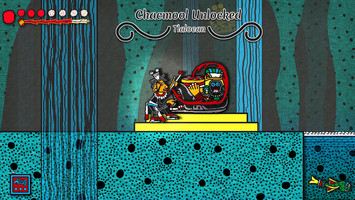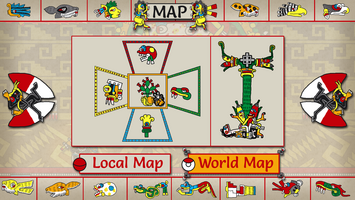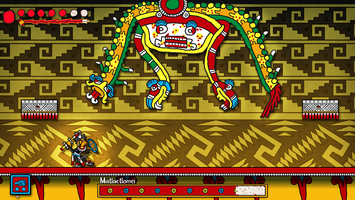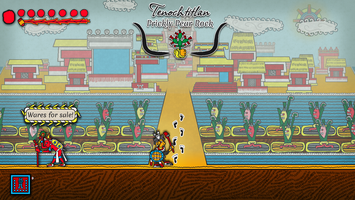Concept Breakdown




This devlog will cover the visual and gameplay inspirations for this project. As it’s visual only with no actual gameplay, this log won’t cover the mechanical ideas too in-depth, although I do discuss them when relevant, and there is a group of additional ideas near the end of the log. The bulk of this log covers the sources of some of the major visual elements in each scene.
Scene 1: Tenochtitlan
In the Aztec cosmos, Tenochtitlan, and more specifically the Templo Mayor, is considered as the center of the world. With that in mind, I consider a vital location to include and I tried my hand at concepting out how the entrance might look. For this I took a lot of inspiration from the Shantae series. Additionally, I didn't make a scene for it for this project, but I have the idea of using a similar mechanic to Shantae: Risky's Revenge for navigating within the city itself, of basically having multiple 2-D planes that the player can "shift" backwards and forwards between, making it easier to have a denser location while still adhering the two dimensional limitations of the chosen art style, speaking of which.
The VAST majority of the artwork in this scene (and really for all the scenes) comes from the Codex Borgia (recently renamed the Codex Yohualli Ehecatl) and you can see several of the temples I used for models in the next image, along with one of the many suns depicted in that Codex. The exceptions of note are the merchant which I derived from the Codex Zouche-Nuttall (renamed Codex Tonindeye), the Templo Mayor in the center-back of the scene, derived from a depiction in the Codex Ixtlilxóchitl, and the "clock" in the bottom left which comes from Codex Telleriano-Remensis. Additionally, I don't recall finding any cloud depictions in the codices so I based their swirls off of those from a wind serpent in the Codex Borgia, felt like a fitting detail to add.
As for the remaining details I haven't touched on, the Health UI is for the most part a placeholder I feel. The health is how I want it, but I'm unsure what mechanic I'd use the bar for. And the city title is also a placeholder for the most part and uses Hollow Knight’s city titles as inspiration, however the font choices are deliberate and attempt to emulate the latin lettering from colonial documents such as the Codex Florentine, so I find that to be a cool detail.
Scene 2: Map Screen
Building off of Tenochtitlan being the center of the cosmos, I had the thought of structuring the game world in a sort of 3-D layout with a world tree in the center and in each cardinal direction, and separate corresponding underworld locations connected by those trees. Now of course I have zero idea at this time on how that would be implemented (though Tomba! for the PS1 could be a good source of inspiration), so I just took the easy route focused on the abstract World Map representation of that idea!
There’s nothing really unique or noteworthy mechanics-wise with this scene, aside from having two separate views to show where the player is in the World, and where they are in the Local area. There is, however, a lot of cool art that was used for the inspiration of this scene. Almost all of it is from the Codex Borgia. However the one big exception to that is the Maltese Cross portion of the world map, which is derived from a depiction of the Mexica peoples’ cosmic world in the Codex Fejervary-Mayer (also known as El libro de Tezcatlipoca). The original image depicts cosmic trees at each corner of the world, and a whole bunch of additional symbolic and religious symbolism, however for my use of it I decided to use day signs, with the glyph for Tenochtitlan in the center, to help give each direction its own character and also represent some of what the player may find there. For example in the North the glyph for Death is used, suggesting a more desolate landscape with enemies and bosses fitting that theme. Likewise for the South the glyph Flower is depicted, suggesting the opposite with more lush and vibrant levels. Each direction would also have their associated deities, and associated player powers. The West has the rain god Tlaloc for example, and so while being more water themed it would also be where the player would acquire a water focused ability (no clue what that would be at this time, but I hope you get the gist).
Now, while there’s a lot of cool details in this scene, the coolest is what’s behind it.
Scene 3: Boss Fight
Leading us to the boss fight scene!
Now I’m not a big UI guy so there’s only so much I can say about the map screen, but here I can talk forever about all the ideas and details! Firstly, the player character. He’s based on an individual known as Stripe Eye in the Codex Borgia (and is in fact the central individual of a very important ritual depicted in that Codex). I’ve intended him to be a placeholder for a future design, but regardless he slots in pretty well. I’ve depicted him using two different kinds of weapons, between this scene, where he’s using a ranged weapon such as an atlatl (though it wouldn’t be used in this manner), and Scene 1, where he’s wielding an axe. I felt it would be important for this game to have a decent variety of weapons to not only allow for different playstyles, but also to reflect the variety of weapons used by the Aztecs. I’m still unsure at this time how I’d structure the combat, but my current thoughts are on implementing standard melee mechanics (such as Blasphemous and Hollow Knight), but allow free-aiming with ranged weaponry (akin to Apotheon’s combat system, though more restricted aiming such as in Super Metroid is also on the table).
Now I would talk about the boss, but there’s not much to say I feel? He’s based off a monster from the Codex Borgia (or half of it really) and there’s really no relation to it beyond that, it just looked like a cool boss to put in; and mechanically, he'd function sort of like a hydra with the player dealing damage to the head of each limb. No, the really cool part for me is its health bar (and the player’s too)! With how old the pre-colonial codices are, specifically the Codex Borgia, there’s lots of heavily damaged areas that are missing tons of pigment. While this is a tragic loss of original information and artwork, it’s still a vital piece of the character of these documents that I’ve based this game’s artstyle on so I figured it would be a good addition to implement a loss of pigmentation in the health bars. This idea also draws some inspiration from Pentiment where the older characters are missing some of their pigmentation to help differentiate from younger characters. I’m unsure if I executed it as well as I could have here, so I’m more than open to additional feedback on that front!
One final detail I’ll discuss from this scene is the background. While most of the artwork up until now has been based off 2-D art from Aztec and Mixtec codices, the background here is instead based off of the incredibly unique and stunning stonework by the Zapotecs in Mitla (located in Oaxaca, Mexico). One of the biggest struggles I had to overcome with these concepts was figuring out what to put in the backgrounds, since as far as I know there’s no depictions of any interiors, at least not in the pre-colonial codices, and the only varied backgrounds depict either water, sort of a shadow effect, or a night sky. Thankfully I was able to learn about Mitla and its beautiful stonework because it fits in this scene so well and really adds a cool background to frame the fight. For the full game I’d likely still come across problems in figuring out how to fill the background, but I can at least find comfort in proving to myself that those are solvable problems.
Scene 4: Chacmool
For the final scene I wanted to try my hand at a new area where I could address the background problem again, along with demonstrating an additional mechanic which involves two very important parts of Mesoamerican religion: auto-sacrifice and Chacmools. Of course it’s understood in popular culture that ritual human sacrifice was an important element in Mesoamerican religions, however what’s probably not as widely known is the importance of auto-sacrifice, essentially self-bloodletting, which could be performed daily and emulated Aztec deities shedding their own blood in the creation of the current world. To incorporate that, I had the idea of the player being able to use some resource of theirs that could be used up/exchanged for something else, such as gaining stronger damage or unlocking certain items (originally I had the thought of trading health and have a risk vs reward element, but through working on this I think it might be better design to use a separate, almost mana bar, for that mechanic. There could be risk vs reward, such as taking more damage if the player uses too much blood, but that would have to be explored through playtesting).
One of the elements I’ve known for a while that I would want the player to actively unlock are Chacmools, these are statues that were ubiquitous throughout Mesoamerica and essentially functioned as sacrificial altars. For this game, given how there’d be a large number which populate the world, I decided they could work well as fast travel points, specifically akin to Hollow Knight’s stag stations or the owl statues in Majora’s Mask. Additionally, they’d do well at adding more of a unique character to each area in which they’re located given their wide variety of designs. This one for example depicts the rain god Tlaloc, and is consequentially located in his realm of Tlalocan, which brings us to the environment.
There was of course no solid basis for the background of this scene, it’s for all intents and purposes a box-standard depiction of a big, dark cave that you could find in just about any other game I’ll admit. But where I was able to make this stand out, I hope, is the texturing. Of course I’ve relied entirely on the original art and stoneworks from the Mexica up until this point, but for this part I got inspiration from a more modern source: Patricia Amlin’s incredible Sacred History of Mexico. It’s a beautifully animated telling of one version of the Aztec people’s creation myth and I highly recommend you watch it, you can find it freely available on Youtube! One of the scenes of that film depicts the creation of the Earth, and during it Patricia and her team made the decision to use this texture on of the mountains/caves, or at least I interpreted it in that manner, and so I decided to use that texture myself and I used that texture rather liberally as shorthand to basically say “hey, this is rock!” I of course didn’t rely entirely on it, I used a pattern in the image editing software to make it look a bit more visually like rock. I’m unsure if this is too cluttered, but at least as of right now I feel like it strikes a good balance between excessive realism and excessive abstraction.
One final thing I want to point out for this scene is obscured a bit by the text, and that is the only piece of art in any of these pieces that has almost no relation whatsoever to the Mexica. This cave art located near El Paso, Texas, in what are known as the Hueco Tanks, was created by people of the Jornada Mogollon culture thousands of years ago, it’d be ancient even to the Aztecs. The reason why I included this is because the Jornada religion was influenced by Mesoamerica, and they depicted both Tlaloc and Quetzalcoatl in their art! That fact, along with Tlaloc being one of the oldest and most consistently worshiped gods in Mesoamerica, is what drove me to include it in this scene. It has no effect on the gameplay whatsoever, hell I doubt I’d find any way to incorporate it into the story, but for me it adds so much by building up and fleshing out the game’s world.
General Mechanics
Here I'll lay out any mechanic ideas I didn't previously cover, or that weren't depicted in a scene.
Health and “Blood” Bar - As I mentioned earlier, I’ve had the idea for a while of allowing the player to exchange health or blood for stronger abilities. I’m still unsure at this time what exactly those would be besides something as simple as more damage or faster movement, but regardless I really like the risk vs reward nature of the idea so I’m adamant about figuring out a solution.
Clock and Day Schedule - In the bottom left of Scenes 1, 3, and 4 is essentially a clock that functions similarly to that in Majora’s Mask. The main difference with that is this game would take place over 5 days instead of 3, and that’s not just an arbitrary increase either! The Aztecs had a 365 day calendar of which the last 5 days, known as Nemontemi, were considered extremely unlucky. The game doesn’t necessarily take place during those 5 days, but as it takes place during the end of the world I figured it’d make sense to at least emulate the idea of those 5 days. Additionally, the 5 days the game takes place over are known as 13- Reed, 1-Jaguar, 2- Eagle, 3- Vulture, and 4-Earthquake. This decision was made because the Aztecs believed the current world would end on the day 4-Earthquake, nothing to really say beyond that.
Nahualli - I didn’t depict it in the scenes here, but another important element of Aztec religion is the concept of a spirit animal. Specifically, there was the belief (and is still held today in some folk beliefs) that one could shapeshift into their Nahualli. So, while I’m unsure on the mechanic details as of right now, Shantae has shown that this could be a fun way to add gameplay and mechanical variety.
Smoky Mirror World - Another thing I didn’t depict in these scenes is an idea I had for a sort of separate world within obsidian mirrors. I’ve yet to pin down on whether this should be a separate area, or an alternate fast travel method, and as far as I know there’s no strong basis for it in Aztec mythology, but it would be a cool way to incorporate more stonework artistry into the game, with the hieroglyphs scene from Prince of Egypt being a good example of how I think it could look.
Encyclopedia and Scanning? - One of my favorite parts in games are the compendiums, civilopedias, encyclopedias, etc. So that's of course something I'd want to include in this game, especially given the historical and cultural relevance the Mexica people still have for today. My prime models for such a system would most likely be CivCity: Rome and Mars Horizon, due to the fact they deal with real world information and history. As for how the entries would be acquired over the course of gameplay, I'm not entirely sure if it should be done through combat (such as Hollow Knight) or if there should be an active scanning mechanic such as from the Metroid Prime series. For implementing an active scanning mechanic, my initial idea is giving the player a partner animal that would inspect the target item for them, thus making it "scanning" mechanically while still fitting within the game world. I don't know, I'll work it out.
Mini-games - One aspect of Mexica culture I really want to include are their games, specifically patolli and the ball game. Patolli is a boardgame that was played rather ubiquitously among the Aztecs, and it would possibly be an easy to add system to the game. The main obstacle is that we don't know all of the rules, so some guesswork and creative liberties with the balancing will likely need to be done, but it would hopefully be a net gain to the experience of the game. The real problem however is the ball game, a sport which was played pretty much everywhere in Mesoamerica and even held spiritual and ritual significance, but which, unlike patolli, was very much played in a 3-D space. So how on Earth I'll translate that into a solely 2-D format I have no idea, but it's a problem I look forward to solving.
Further Ideas and Potential Issues
Of course I’m very glad with how this turned out, but I’m positive I still have a lot of work to do beyond simply working on a prototype or demo in the future. One of the main problems I believe I’ll need to overcome is making design decisions because they make sense for the game, not simply because there’s a historical basis for them. For example, the Nahualli mechanic, while having a solid basis in Aztec culture, might not be a good fit for the game depending on the direction I go. Some other problems I’ll definitely encounter are how to not only make exploring the world of ancient Mexico fun and exciting, but also accurate and respectful. There are some gruesome details that could affect audience/market appeal, such as the fact some priests (and even one of the gods, Xipe Totec) wore flayed human skin, but that would be doing a disservice I feel if I omitted them from the game. Likewise, I had the idea of introducing a sort of branching ending to the story where the player could decide if the practice of human sacrifice remains in place or not, which has some basis in Aztec mythology and history (specifically with Topiltzin of the Toltecs, and one of Nezahualcoyotl’s in which sacrifice was not allowed), but I’m unsure if modern Nahua peoples would find such a choice to be disrespectful. While there’s definitely more pressing concerns than how a video game of all things decides to depict an ancient culture, I’d still want to treat this topic with the utmost care and respect that I possibly can, especially if it became someone’s first ever exposure to Aztec culture. So in short, while I’ve made a big step in making this project a reality with these concepts, I’m still a LONG way from actually being done, and I’m excited for that.
Get Amo Tocaitl (Concept)
Amo Tocaitl (Concept)
Mockup for a mythological adventure through ancient Mexico
| Status | Prototype |
| Category | Other |
| Authors | macleodian, Twin Reality Studios |
| Genre | Adventure |
| Tags | 2D, Colorful, Metroidvania, mythology, Prototype |
Leave a comment
Log in with itch.io to leave a comment.